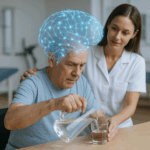Physiotherapy Treatment Protocol for Post-Traumatic Adhesive Capsulitis
Overview of Conditions:
Post-traumatic adhesive capsulitis (PTAC) develops following a traumatic injury to the shoulder, such as fractures, dislocations, or rotator cuff tears, leading to inflammation and fibrosis in the shoulder capsule. The initial trauma causes acute inflammation, which is followed by the development of adhesive capsulitis as the injury heals. This condition results in significant stiffness, pain, and limited range of motion (ROM), particularly in external rotation, abduction, and flexion. The post-traumatic nature of this condition may delay recovery and complicate the rehabilitation process. Treatment aims to reduce inflammation, prevent or minimize capsular fibrosis, restore ROM, and improve functional mobility.
Assessment and Evaluation:
- History:
- A history of traumatic injury (fractures, dislocations, shoulder surgery).
- Timeline of recovery since the incident.
- Progressive pain and loss of mobility after the initial healing phase of the injury.
- Pain Assessment:
- Use Visual Analog Scale (VAS) or Numeric Pain Rating Scale (NPRS) to assess pain intensity during activity, rest, and motion.
- Assess for pain that worsens during specific movements or functional activities (e.g., reaching, lifting).
- Physical Examination:
- Postural Assessment: Examine for altered posture or compensations due to pain and stiffness.
- ROM Testing: Limited active and passive ROM, particularly in external rotation and abduction, and difficulty with functional overhead movements.
- Strength Testing: Weakness in the rotator cuff and scapular stabilizers due to pain and muscle inhibition during the acute phase.
- Special Tests:
- Glenohumeral Joint Passive ROM: Assess for tightness in the shoulder capsule, especially in external rotation and abduction.
- Painful Arc Test: Pain and restricted movement between 60° and 120° of shoulder abduction.
- Scapular Dyskinesis:
- Assess for abnormal scapular movement, which could affect shoulder joint function during rehabilitation.
Goal Setting:
Short-Term Goals:
- Pain Control: Reduce pain to a manageable level (VAS ≤ 3) during movement and functional activities.
- Increase ROM: Improve passive and active shoulder ROM, particularly in external rotation, abduction, and flexion.
- Minimize Inflammation: Decrease inflammation and swelling in the shoulder joint.
- Muscle Relaxation: Alleviate muscle guarding around the shoulder and scapular region.
- Maintain Functional Capacity: Prevent further functional limitation through early intervention.
Long-Term Goals:
- Restore ROM: Achieve near-normal ROM, particularly in external rotation, abduction, and flexion.
- Strengthening: Strengthen the rotator cuff and scapular stabilizers to support shoulder function.
- Functional Recovery: Restore full functional capacity, including overhead activities and lifting.
- Prevent Recurrence: Educate the patient on shoulder mobility exercises and strategies to prevent re-injury.
Recommended Treatment:
Electrotherapy:
- Transcutaneous Electrical Nerve Stimulation (TENS):
- Indication: Pain relief, especially during the acute and subacute phases.
- Parameters: Frequency 80-120 Hz; Intensity: Comfortable sub-threshold intensity; Pulse Width: 100-300 µs; Duration: 20-30 minutes, 2-3 times per day.
- Mechanism: TENS stimulates sensory nerves to block pain signals and manage muscle spasms.
- Interferential Therapy (IFT):
- Indication: Deeper pain relief and reducing swelling.
- Parameters: Frequency: 4,000 Hz carrier frequency modulated at 80-150 Hz; Duration: 20-30 minutes per session.
- Mechanism: IFT promotes deeper tissue penetration to alleviate pain and enhance circulation for tissue healing.
- Class 4 LASER Therapy:
- Indication: Tissue healing, inflammation reduction, and collagen synthesis.
- Parameters: Wavelength: 800-900 nm; Power: 5-10 W; Duration: 5-10 minutes per treatment area.
- Mechanism: LASER therapy accelerates soft tissue repair and restores shoulder mobility through enhanced cellular activity and collagen production.
- Ultrasound Therapy:
- Indication: Reducing fibrosis, improving circulation, and promoting tissue remodeling.
- Parameters: Frequency: 1 MHz for deeper penetration; Intensity: 1.0-1.5 W/cm²; Duration: 8-10 minutes per area.
- Mechanism: Ultrasound enhances blood flow and breaks down fibrous tissue to restore ROM and reduce stiffness.
Thermotherapy:
- Moist Heat Packs:
- Indication: Tissue extensibility and muscle tension relief before exercises.
- Application: Apply for 15-20 minutes before stretching or mobilization exercises.
- Mechanism: Heat increases blood flow and relaxes muscles, improving ROM during rehabilitation.
Manual Therapy:
- Joint Mobilization (Grade III-IV):
- Indication: Improving glenohumeral joint mobility and addressing capsular stiffness.
- Technique: Use oscillatory or sustained mobilizations targeting the posterior and inferior capsule.
- Mechanism: Mobilizations stretch the capsule, increase synovial fluid movement, and improve ROM.
- Myofascial Release:
- Indication: Muscle tension reduction and fascial restriction release in the shoulder and surrounding musculature.
- Technique: Apply sustained pressure to tight muscles and fascia, followed by stretching.
- Mechanism: Myofascial release reduces pain, improves muscle function, and enhances ROM.
Exercise Therapy:
- Range of Motion (ROM) Exercises:
- Exercise: Begin with passive and active-assisted ROM exercises, progressing to active ROM.
- Duration: 3-5 sets, 3-5 repetitions, 3-4 times per day.
- Mechanism: ROM exercises break down adhesions in the shoulder capsule and prevent contractures.
- Strengthening Exercises:
- Exercise: Begin with isometric strengthening for rotator cuff and scapular stabilizers, progressing to dynamic exercises with resistance bands or light weights.
- Duration: 2-3 sets, 10-12 repetitions, 3 times per week.
- Mechanism: Strengthening exercises support shoulder stability and reduce the risk of injury.
- Stretching:
- Exercise: Incorporate gentle stretching for the shoulder joint using PNF or hold-relax techniques.
- Duration: Hold each stretch for 20-30 seconds, 2-3 repetitions, 2-3 times per day.
- Mechanism: Stretching helps restore the length of the shortened shoulder capsule and muscles.
Precautions:
- Electrotherapy: Avoid use over the heart or on patients with pacemakers, and not on open wounds or in the immediate post-operative period.
- Thermotherapy: Do not apply heat in the inflammatory phase (first 48 hours) with ongoing swelling or acute injury. Monitor for skin irritation or burns.
- Manual Therapy: Avoid aggressive joint mobilizations that could exacerbate pain or inflammation. Monitor for any signs of irritation.
- Exercise Therapy: Gradually increase exercise intensity to avoid overloading the shoulder, particularly in the early stages.
Reassessment and Criteria for Progression/Change in Care Plan:
- Pain Reduction: If pain persists despite 6-8 weeks of therapy, consider advanced imaging or surgical referral.
- ROM: If ROM does not improve after 4-6 weeks, reassess the treatment plan and consider more aggressive interventions.
- Strength and Function: Progress to functional strengthening exercises once pain is controlled and ROM improves, addressing any weakness or compensatory movement.
Disclaimer and Note:
The treatment options presented above should be selected based on individual patient needs, availability of resources, and clinical judgment. For electrotherapy, thermotherapy, and manual therapy, choose the most appropriate modality for the patient’s condition and phase of recovery. This protocol serves as a guide, and the treatment plan should be adjusted as needed based on the patient’s progress. Always consult with a qualified healthcare provider before initiating treatment.
References:
- Cleland, J. A., & Vance, C. (2020). “Management of Adhesive Capsulitis: A Review of the Evidence.” Journal of Manual & Manipulative Therapy, 28(1), 12-20. https://doi.org/10.1080/10669817.2020.1720228
- Wong, K., et al. (2021). “Post-Traumatic Adhesive Capsulitis of the Shoulder: A Comprehensive Review.” British Journal of Pain, 35(4), 507-518. https://doi.org/10.1177/2049463721100579
- Leveille, E. T., et al. (2022). “Rehabilitation for Post-Traumatic Shoulder Adhesive Capsulitis: A Critical Review.” Journal of Orthopaedic & Sports Physical Therapy, 52(5), 342-351. https://doi.org/10.2519/jospt.2022.10839






